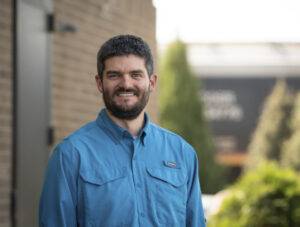Making Our Way to Main Street: Walking & Biking in Small Towns and Rural Areas
For those who never dreamed of city life or have lived it and wonder what else could there be, the appeal of rural areas on quiet acres of vast land or the small-town charm of a fictional friendly town like Stars Hollow from Gilmore Girls, never really goes away. If you’re driving down a busy city road and pass by an old friend, you’ll likely honk or wave to get their attention, then keep driving down the road. But when you’re walking down a small-town path and see an old friend, you’ll likely stop and chat for a while, maybe even make plans to get together. Creating safer and more attractive places to walk or bike in small towns and rural areas helps bring a community together by fostering accessibility to places that promote social interaction, while increasing recreation opportunities and improving overall health.
The main goal for many communities looking to create walkable and bikeable towns is to give residents increased access to popular local destinations, such as libraries, parks, and other open spaces. Connor Cox, Senior Transportation Planner at Bolton & Menk, explained that “these facilities allow people who cannot drive (due to age, income, or disability) the opportunity to reach community destinations without a vehicle.”
Misconceptions: But People Don’t Walk or Bike as Much in Small Towns or Rural Areas… Do They?
While that is often true in rural areas due to long distances between destinations, small town development patterns are usually very advantageous for walking and biking. One of the big advantages for small towns is they often have compact town centers with a concentration of community destinations all within proximity. They also often have smaller block sizes which enhances walkability. Neighborhood streets in small towns tend to have lower traffic volumes than neighborhood streets in bigger cities, so they may feel more safe and comfortable for people walking and biking.
Many small towns typically have a walkable ‘Main Street’ with a broad mix of restaurants, services, and other commercial destinations. Networks of walking and biking facilities in smaller towns can connect many vital destinations and community resources within a relatively compact area.
People often believe that dedicated biking and walking infrastructure is only beneficial in larger cities or urban areas. While physically separated bike infrastructure (separated bike lanes) is more common in denser areas due to higher volumes of bicyclists and pedestrians, other facilities, such as shared use paths, side paths, on-street bike lanes, and paved shoulders are often appropriate and incredibly beneficial in both small towns and rural areas.
In rural areas specifically, obesity rates are approximately 6.2 times higher than in urban America, yet, many rural communities do not have the resources to address this critical health concern. Residents in rural areas typically need to travel longer distances to access places urban areas take for granted – healthcare facilities, grocery stores, and exercise facilities. Providing walking and biking facilities in rural communities offers residents an opportunity to increase both their social and physical activities while improving their overall health.
South Bend Township: Small Town Multimodal Safe Routes
In the South Bend Township, the Mankato/North Mankato Area Planning Organization (MAPO) partnered with Blue Earth County and South Bend Township to identify areas of Hemlock Road (CSAH 33) and South Bend Avenue (CSAH 69) to improve with safe, multimodal facilities that provide better travel opportunities for people living and working in the area. These roads provide important connections for residential development and a variety of commercial and industrial uses along the corridors to US 169, the City of Mankato, and beyond.
On these portions of roadway, there are currently no dedicated facilities for people walking or biking. Bolton & Menk helped complete a study for Hemlock Road and South Bend Avenue that created a comprehensive vision and prepared the street for reconstruction projects. For future corridor improvements, the study defined issues and potential opportunities, established a vision and goals, and developed multimodal infrastructure improvement options and an implementation plan, including cost estimates.

During pop-up engagement events at Clark gas station and a summer golf fundraiser, feedback was gathered from potential users and community members. The community member input was used when creating the final options for the corridor study.
For Hemlock Road (CSAH 33), the recommendation was to add a shared use path on the east side of the road and to continue the path south so that it connects to an existing trail north of Hawthorn Road. Both alternatives connect residents in the western part of town to the town center and the recreational facility along Hawthorn Road.

On South Bend Avenue (CSAH 69), the study recommended paved shoulders be installed on both sides of the roadway, with the south side connecting directly to the new Hemlock Road improvements and the north side connecting to the Chapman Street convenience store and the Minneopa Trail along Highway 169.
City of Le Sueur: A Small Town’s Conversion of a Trunk Highway to a County Road
In the City of Le Sueur, Trunk Highway (TH) 112 was riddled with poor pavement conditions and lacked pedestrian and bike facilities for easier access to Legion Park, Le Sueur High School, and Main Street. Under the surface, waterline, sewer, and electrical improvements were also major issues that needed to be addressed.
Le Sueur County and the Minnesota Department of Transportation (MnDOT) developed a plan for the turnback of TH 112 from County Road 115 to TH 169. Since TH 112 would be turned over from the state to the county, where the corridor is now referred to as County State Aid Highway (CSAH), the state needed to provide funding for its improvements.
The city lobbied the county to include a shared-use path, rather than a sidewalk, in the comprehensive plan and it was subsequently added to the project, with the city to pay for the upgrade. Because of the passion for this project, the city also revised their Sidewalk & Trail Maintenance Policy that stated the city would remove snow and ice from sidewalks that are opposite of city trails, improving safety for all community members.
The public was engaged through four open houses and a series of property owner meetings. Input gathered during the series of open houses was integrated into the various design stages, arriving at a final design that had both community and agency support.
“Trails and sidewalks allow for active living and active transportation throughout a community,” Le Sueur County explained. On the southern mile of the corridor, an 8-foot trail was installed along the east side of Elmwood Avenue and on the northern 0.5-mile, a 5-foot sidewalk was installed on the west side of Elmwood Avenue with an 8-foot trail on the east side. This now allows bicyclists and pedestrians to navigate the south side of town easily and safely. Additional sidewalks were placed on Ferry Street, 4th Street, and Bridge Street to allow for easier access to Main Street. To create accessible areas to people of all abilities, concrete pedestrian ramps were installed on both road sections to align with ADA standards.

This new pedestrian and bicycle network now provides transportation alternatives for residents of Le Sueur to access Legion Park, Le Sueur High School, and the newly revitalized Main Street, as well as recreational opportunities along Elmwood Avenue to the south of the city.
In October 2020, the project was completed, followed by positive feedback from public agencies and community members. Adjacent homeowners have since expressed excitement over the new pedestrian facilities, and the shared use path has been used frequently. Le Sueur County staff emphasized how the improved trail network “strengthens recreational opportunities, economic opportunities, and overall quality of life [for the people who live here].”
The Benefits of Walkable and Bikeable Infrastructure in Small Towns and Rural Areas
While the implementation of walking and biking facilities in small towns and rural areas provide increased opportunities for community members to socialize and visit community destinations, the benefits of enhancing active transportation networks in these areas are numerous and extend far beyond the goal of creating more accessible communities. These networks reduce traffic congestion, increase residents’ safety, improve air quality, increase community members’ activity levels, and improve their overall health, both physically and mentally.
While these changes might seem simple on the outside, the overall benefits to the community members enjoying and using the new walking and biking infrastructure can create lasting effects that impact the community long after these projects have been implemented.
 Connor Cox is a senior transportation planner on the Bolton & Menk team who began his career in 2012. He is responsible for leading active transportation planning work across Bolton & Menk’s Midwest locations. His passion stems from the impact his work makes in the communities he serves — “When we help develop a connected network of multimodal transportation facilities, we provide community members with more transportation options that are safe, attractive, healthy, and enjoyable.”
Connor Cox is a senior transportation planner on the Bolton & Menk team who began his career in 2012. He is responsible for leading active transportation planning work across Bolton & Menk’s Midwest locations. His passion stems from the impact his work makes in the communities he serves — “When we help develop a connected network of multimodal transportation facilities, we provide community members with more transportation options that are safe, attractive, healthy, and enjoyable.”
Cody Christianson , PE, ENV SP, is a senior associate and transportation project manager at Bolton & Menk who began his career in transportation engineering in 2008. He leads Bolton & Menk’s Active Transportation Services group across the Midwest, Southeast, and Southwest operations. Cody has national bicycle and pedestrian expertise that helps build support for improved multimodal infrastructure. By listening to community input, coordinating with project stakeholders, and using his industry experience, Cody designs improvements that create an inviting environment, enhance pedestrian and bicycle safety, and address community goals.
, PE, ENV SP, is a senior associate and transportation project manager at Bolton & Menk who began his career in transportation engineering in 2008. He leads Bolton & Menk’s Active Transportation Services group across the Midwest, Southeast, and Southwest operations. Cody has national bicycle and pedestrian expertise that helps build support for improved multimodal infrastructure. By listening to community input, coordinating with project stakeholders, and using his industry experience, Cody designs improvements that create an inviting environment, enhance pedestrian and bicycle safety, and address community goals.

